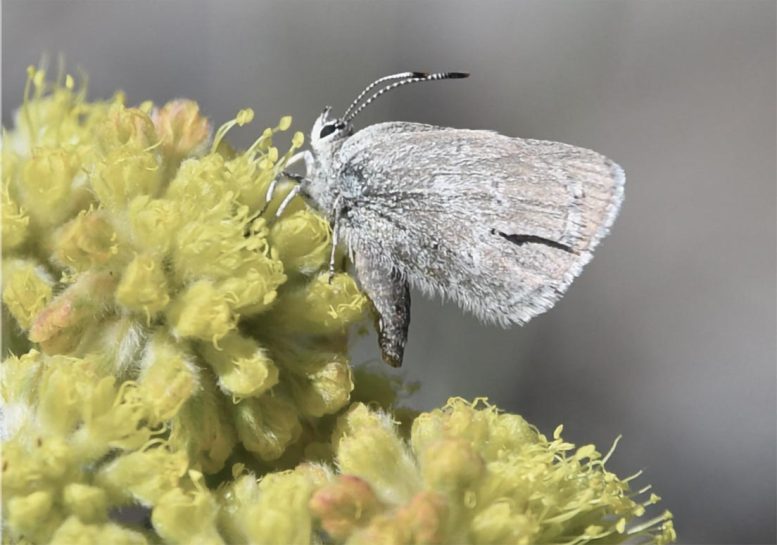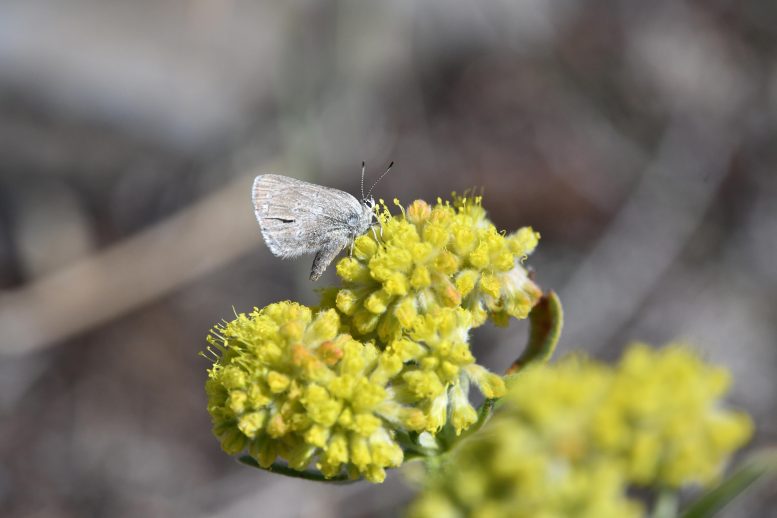
A new butterfly species, Satyrium curiosolus, has been discovered in Alberta. Isolated for millennia, it shows unique traits and faces conservation risks due to low genetic diversity.
In Canada’s Rocky Mountains, a modest yet remarkable butterfly has gone largely unnoticed by science for years. With a wingspan ranging from one to one and a half inches, and wings that are brown on top and greyish brown with black spots underneath, this butterfly was long believed to be part of the Half-moon Hairstreak species (Satyrium semiluna). However, researchers have now confirmed that the isolated hairstreak butterflies living in Blakiston Fan, within Waterton Lakes National Park in Alberta, represent a distinct species: Satyrium curiosolus, or the Curiously Isolated Hairstreak.
A recent study by an international team, published in ZooKeys, revealed the butterfly’s unique evolutionary background. The findings were striking: Satyrium curiosolus has likely been isolated from its closest relatives for as long as 40,000 years, gradually developing distinct genetic and ecological traits.

The science behind the discovery
“Our whole-genome sequencing of S. curiosolus revealed strikingly low genetic diversity and exceptionally high levels of historical inbreeding compared to the geographically nearest S. semiluna populations in British Columbia and Montana, more than 400 km distant,” explains co-first author Zac MacDonald, a La Kretz postdoctoral researcher at the University of California Los Angeles Institute of the Environment and Sustainability.
Although the population is small, genetic evidence indicates that S. curiosolus has remained a stable and independent lineage for tens of thousands of years.
“Like the Channel Island Fox, S. curiosolus may have purged some of its harmful recessive genetic variation through a long, gradual history of inbreeding, allowing it to persist as a small and completely isolated population today,” MacDonald adds.

Satyrium curiosolus is found in a distinct habitat unlike any other population of S. semiluna that we know of. While its relatives thrive in sagebrush steppe, S. curiosolus occupies a single alluvial fan that is more accurately described as prairie-grassland, where it associates with different plants and ant species. Satyrium curiosolus relies exclusively on silvery lupine (Lupinus argenteus) for larval development, a plant not known to be used by S. semiluna populations in British Columbia.
“Furthermore, we recently discovered that S. curiosolus larvae have mutualistic relationships with a particular species of ant (Lasius ponderosae), which has not been observed in other S. semiluna populations,” says James Glasier of the Wilder Institute/Calgary Zoo, who was also part of the study. Satyrium curiosolus caterpillars provide the Lasius ants with a sugary excretion called honeydew to eat, while in return the ants protect the caterpillar from parasites and predators. Caterpillars also retreat into ant galleries when disturbed, or when it gets too hot out, and adult females have been observed laying eggs right near the entrances to Lasius colonies under Silvery Lupines.
Why it matters
The recognition of S. curiosolus as a species has important implications, highlighting its unique evolutionary trajectory and emphasizing an urgent need for tailored conservation strategies.
Satyrium curiosolus faces a somewhat unique challenge: its long-term isolation has resulted in very low genetic diversity, which means that the species has a reduced potential to adapt to changing climatic conditions. While conservationists often consider genetic rescue—introducing individuals from related populations to boost genetic diversity—as a solution to low genetic diversity, the distinctiveness of S. curiosolus raises concerns about potential outbreeding depression when mixed with S. semiluna.

It is likely that the two species are not even reproductively compatible, meaning S. curiosolus may be on its own. Conservation efforts must now consider new solutions, such as establishing additional S. curiosolus populations, to help this butterfly persist as climate change threatens ecological change at Blakiston Fan.
A case study in genomics and conservation
“The discovery of S. curiosolus is a powerful demonstration of how genomics is revolutionizing taxonomy and conservation,” remarked co-first author Julian Dupuis, an Assistant Professor in the Department of Entomology at University of Kentucky. “While traditional taxonomic methods often rely on morphology alone, our study underscores the importance of integrating genomic and ecological data to uncover hidden diversity. With the rise of genomic tools, previously unrecognized species like S. curiosolus are being discovered, highlighting the need for conservation strategies that account for cryptic biodiversity,” Dupuis adds.
Collaboration in conservation
“Our studies on S. curiosolus and S. semilunahighlight the importance of collaboration between academic scientists, nonprofit organizations, and conservation managers. All of this work was made possible through partnerships between academic researchers, Parks Canada, and the Wilder Institute/Calgary Zoo. By combining expertise in genomics, field ecology, and conservation management, we were able to produce findings that not only reshape our understanding of biodiversity but also provide actionable insights for species protection. Moving forward, these interdisciplinary collaborations will be critical for tackling complex conservation challenges and ensuring the long-term survival of species like S. curiosolus,” added MacDonald.

The future of Satyrium curiosolus
Recognizing S. curiosolus as a distinct species is just the beginning, the researchers say. Future research should explore its evolution and interactions with other species, like host plants and ants. Additionally, long-term monitoring by Parks Canada and the Wilder Institute/Calgary Zoo will be essential to assess how this species copes with climate change and what conservation actions are appropriate. “This is a wonderful example of how such monitoring can connect diverse approaches and impactful answers to a simple question like ‘that’s odd – why is it there?’”, says anchor author Felix Sperling, a professor at the University of Alberta and curator of the U of A’s Strickland Museum of Entomology.
“For now, the Curiously Isolated Hairstreak reminds us that even the smallest and most overlooked species can hold extraordinary scientific and conservation significance,” the researchers say in conclusion.
Reference: “Genomic and ecological divergence support recognition of a new species of endangered Satyrium butterfly (Lepidoptera, Lycaenidae)” by Zachary G. MacDonald, Julian R. Dupuis, James R. N. Glasier, Robert Sissons, Axel Moehrenschlager, H. Bradley Shaffer and Felix A. H. Sperling, 17 April 2025, ZooKeys.
DOI: 10.3897/zookeys.1234.143893
Never miss a breakthrough: Join the SciTechDaily newsletter.
1 Comment
I didn’t know we had butterfly nerds for 40,000 years to pursue them. Shows the true value of the human mind.